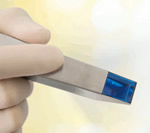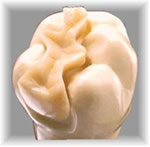Inlays-Onlays
In dentistry, an inlay is an indirect restoration (filling) consisting of a solid substance (as gold or porcelain) fitted to a cavity in a tooth and cemented into place. An onlay is the same as an inlay, except that it extends to replace a cusp. Crowns are onlays which completely cover all surfaces of a tooth.

Inlays:
Sometimes, it is needed to restore a tooth with an intracoronal restoration, but the decay or fracture is so extensive that a direct restoration, such as amalgam or composite, would compromise the structural integrity of the restored tooth by undermining the remaining tooth structure or providing substandard opposition to occlusal (ie: biting) forces.
Onlays:
When decay or fracture incorporate areas of a tooth that make amalgam or composite restorations essentially inadequate, such as cuspal fracture or remaining tooth structure that undermines perimeter walls of a tooth, an onlay may be indicated.
Similar to an inlay, an onlay is an indirect restoration which incorporates a cusp or cusps by covering or onlaying the missing cusp.
 Technique:
Technique:
Inlay/onlay placement is usually carried out over two appointments. During the first visit, an impression will be taken after a laser preparation of the tooth and a temporary filling will be placed over the tooth. the impression is then sent off to a dental lab, which will create the inlay/onlay to match the tooth specifications.
On the second visit, the temporary filling will be removed and the permanent restoration will be placed over the tooth. With Cerec Blue cam You will only need one single visit and No temporary filling..!
Benefits:
In treating dental decay, inlays and onlays help to eliminate tooth sensitivity and eventual tooth loss. Inlays and onlays also offer the following benefits:
Since they can be made from tooth-colored material, including porcelain and composite resin, inlays and onlays are virtually invisible.
Unlike metal fillings, inlays and onlays will not expand or contract in response to temperature changes caused by hot or cold foods. This change in size can cause teeth to weaken or fracture.
The use of inlays and onlays requires less tooth reduction than does the use of metal fillings. This allows to conserve more of a patient's natural tooth structure in the treatment process.
Because of the way inlays and onlays are made, they help to strengthen teeth by up to 75 percent.
The durable material from which inlays and onlays are made helps them last up to 30 years, much longer than that of conventional fillings.
Inlays and onlays can replace silver fillings to create a healthier, more natural-looking smile.
By saving decayed teeth, inlays and onlays prevent the need for more extensive treatment later on.
